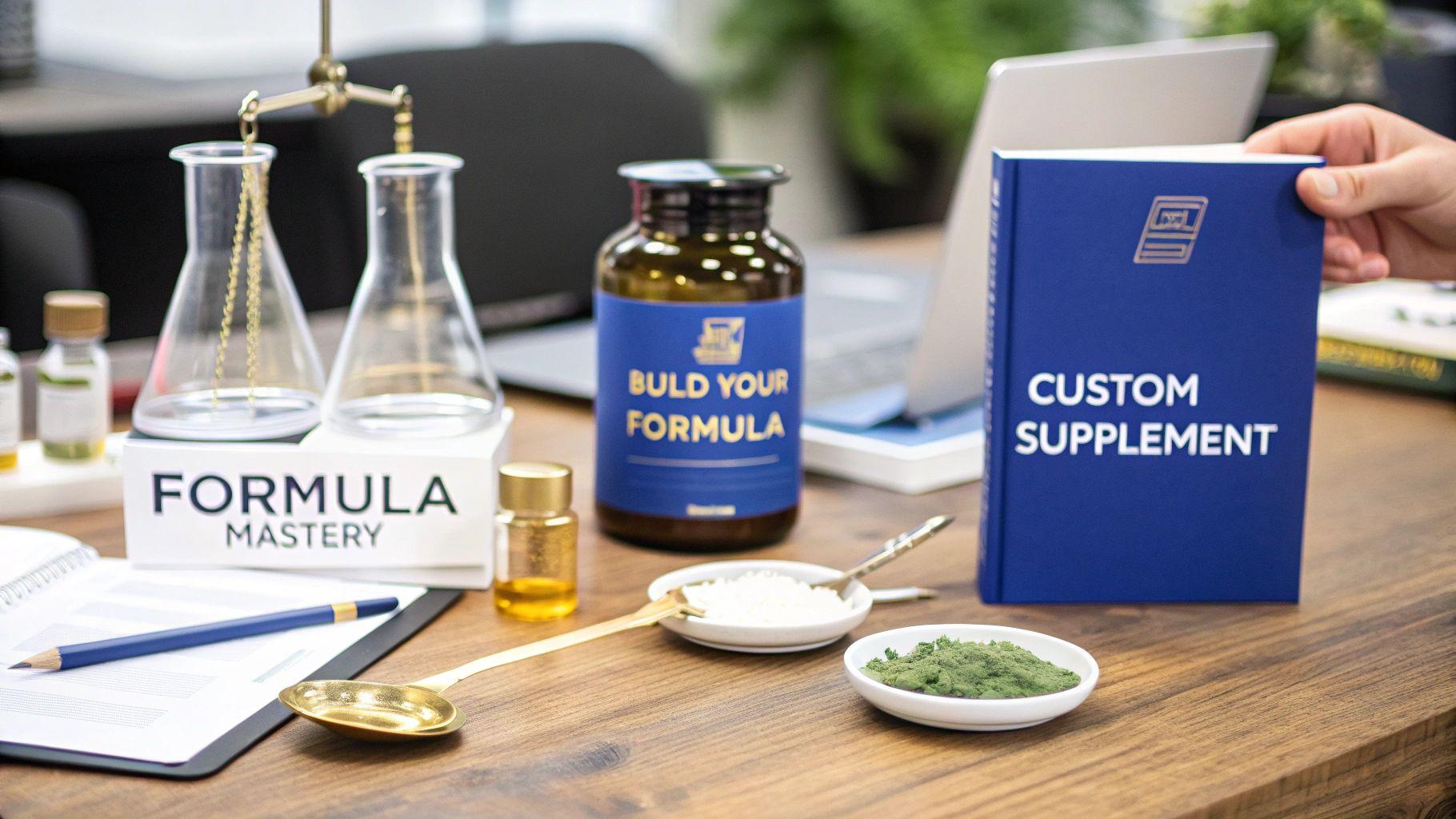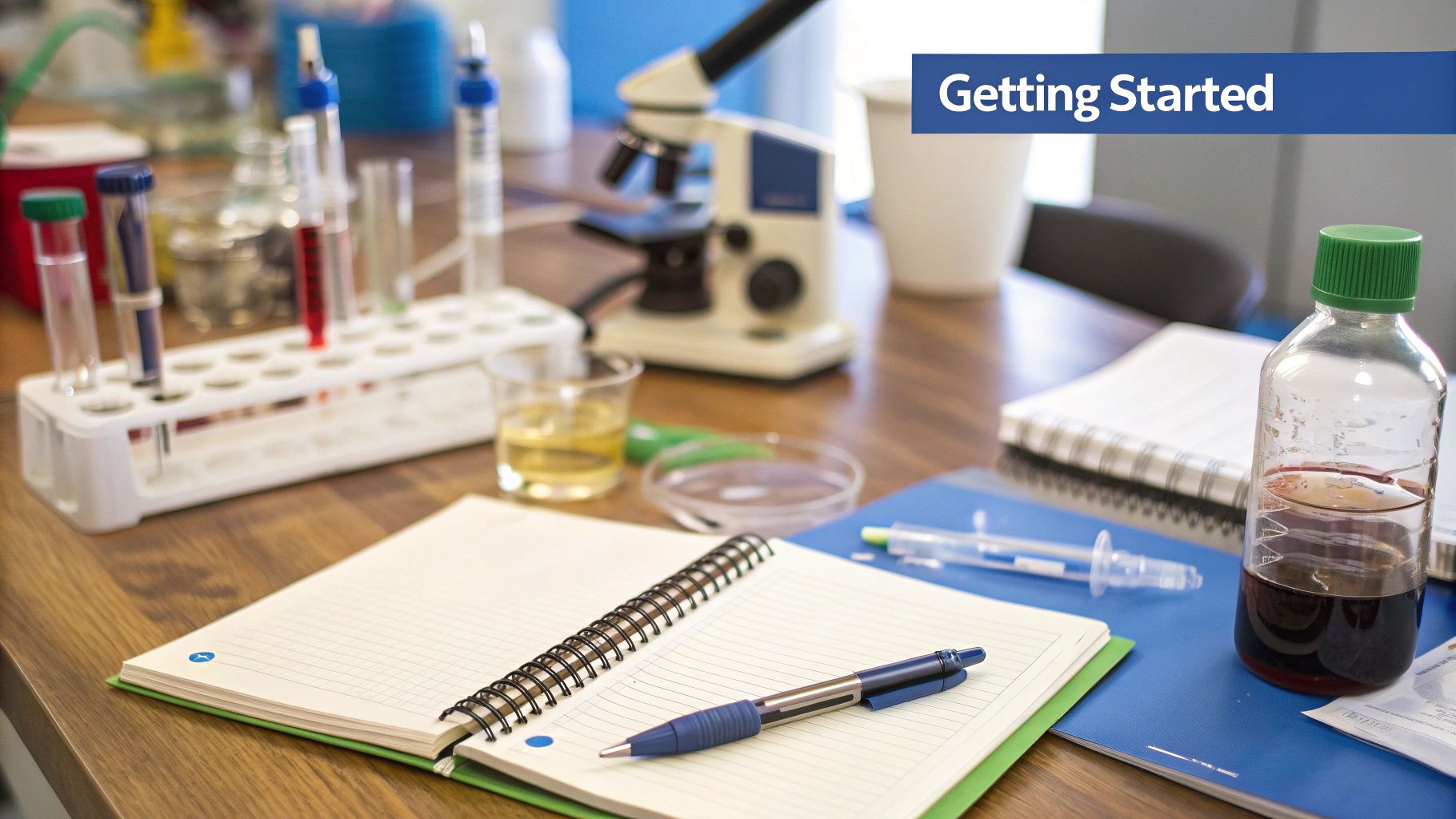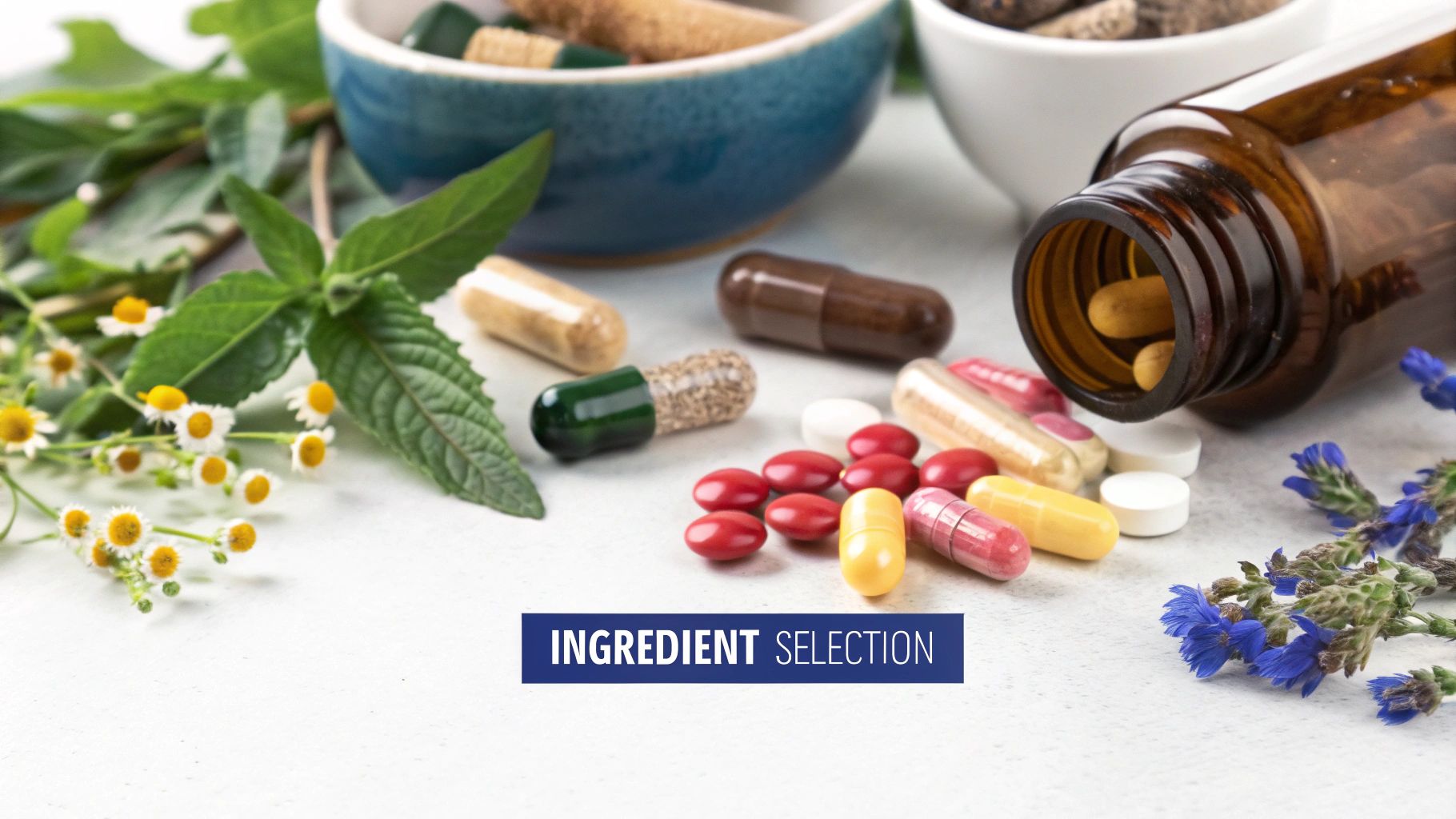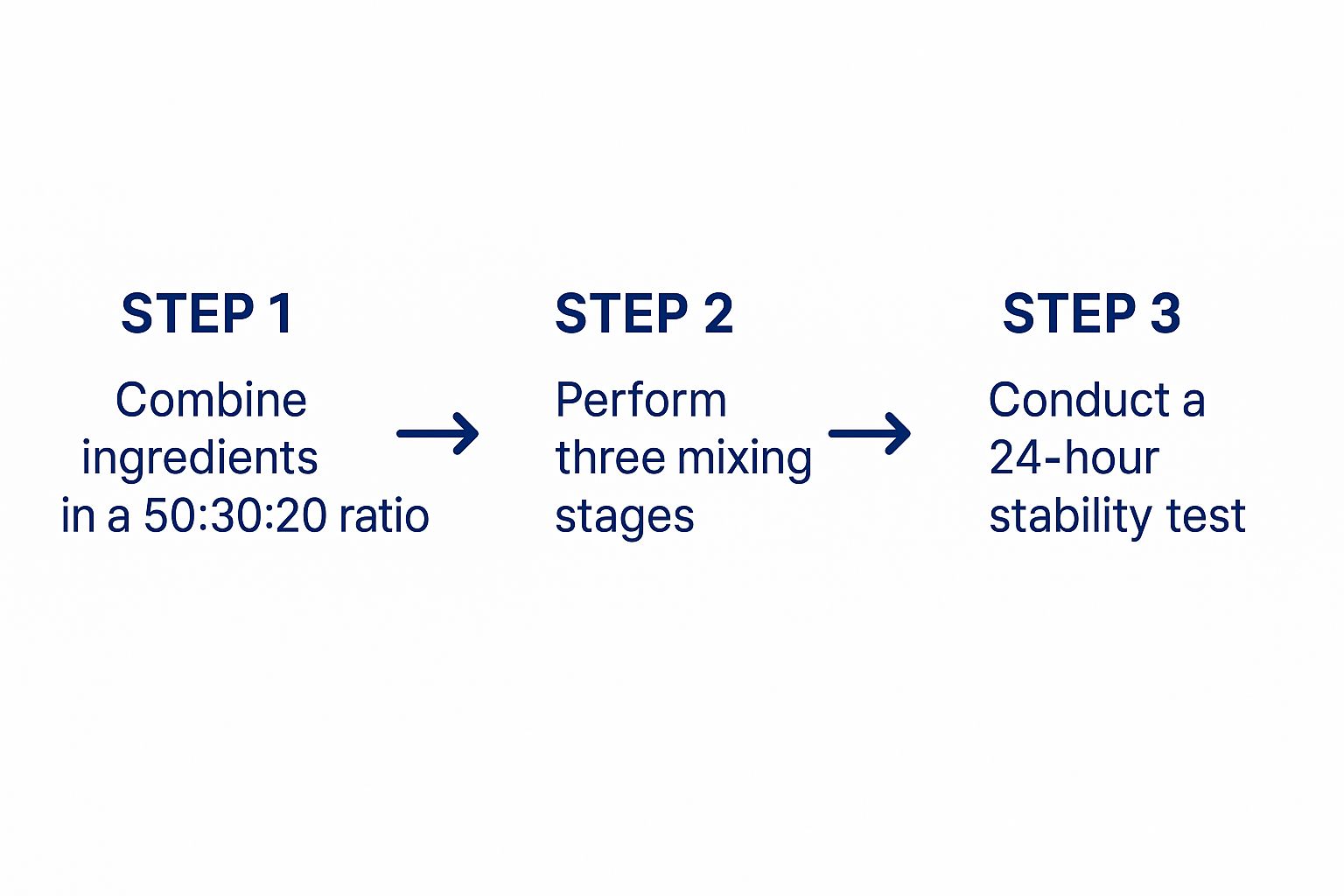How to Create a Supplement Formula From Scratch
Learn how to create a supplement formula with this definitive guide. We cover concept, ingredient research, sourcing, and regulatory compliance.
 Get a Free Quote Today!
Get a Free Quote Today!Before a single gram of any ingredient gets measured, a winning formula starts with a crystal-clear vision. Jumping straight into picking ingredients without this prep work is like trying to build a house without a blueprint. You might end up with a pile of high-quality materials, but they won't come together to create something that’s both effective and structurally sound.
Defining Your Supplement's Purpose and Audience

The very first question you need to answer is: What specific problem is my supplement going to solve? And I mean specific. "Promoting overall wellness" is far too vague to build a compelling product around. You need to zero in on a precise goal.
- Are you aiming to boost athletic recovery for endurance runners?
- Is the goal to deliver sharper cognitive function for busy professionals?
- Do you want to create a blend that supports deeper, more restful sleep for adults with hectic lives?
This kind of focus is your foundation.
Pinpointing Your Ideal Customer
Once you have a clear purpose, you need to know exactly who you're making it for. This isn't just a marketing exercise; it's a critical formulation step. Different groups of people have wildly different needs, expectations, and even physiological responses. A formula that works wonders for a 25-year-old bodybuilder might be completely wrong for a 65-year-old looking for joint support.
Let’s look at a few examples:
- Elite Athletes: They need peak performance, proven efficacy, and absolute certainty that ingredients are free of banned substances.
- Busy Professionals: They’re looking for convenience, mental clarity, and stress relief. Their supplements must be easy to take and fit into a fast-paced schedule.
- Aging Adults: This demographic often prioritizes safety, gentler dosages, and long-term health benefits, like supporting bone density or cardiovascular wellness.
Understanding these nuances is everything. The global dietary supplements market was valued at around USD 189.23 billion in 2024 and is expected to hit USD 402.20 billion by 2034. That explosive growth is driven by consumers in specific demographics looking for targeted solutions. Digging into the data helps you find those pockets of opportunity.
Building Your Product Concept Brief
All this strategic thinking should come together in a product concept brief. Think of this document as your North Star, guiding every single decision you make from here on out. It’s more than just a rough idea; it’s a detailed plan that ensures your supplement is not only scientifically sound but also has a clear place in the market. Just as you need a clear market focus, using good strategic planning templates can give you a solid framework for your entire process.
To help you get started, here’s a breakdown of what should go into your brief.
Core Components of a Product Concept Brief
A summary of the essential elements to define before you begin formulating your supplement.
| Component | Key Questions to Answer | Example (Cognitive Support Supplement) |
|---|---|---|
| Product Purpose | What specific problem does this solve? What is the primary benefit? | To enhance focus, memory, and mental clarity for working professionals and students. |
| Target Audience | Who is the ideal customer? (Age, lifestyle, pain points) | Professionals aged 30-50, students, and entrepreneurs facing mental fatigue and high-pressure deadlines. |
| Key Ingredients | What are the 3-5 core ingredients you are considering? | Bacopa Monnieri, Lion's Mane Mushroom, L-Theanine, Rhodiola Rosea. |
| Unique Selling Proposition (USP) | What makes this product different or better than competitors? | A synergistic, non-stimulant blend that improves cognitive function without causing jitters or a crash. |
| Dosage Form | How will it be delivered? (Capsule, powder, liquid) | Easy-to-swallow vegan capsules. |
Finalizing this brief forces you to get serious about your goals and how you'll achieve them.
Key Takeaway: A product concept brief transforms a good idea into a viable business plan. It forces you to articulate your unique selling proposition (USP) and justify why your product deserves a place in a crowded market.
This foundational planning isn't just a box to check—it's the most important part of the entire process. It sets the stage for creating a product that truly connects with customers and delivers results. For anyone looking to go beyond just the formula, a strong brief is also the first chapter of your business plan. You can read our guide on how to start a supplement business for a complete overview of that bigger journey: https://tritonnutragroup.com/blog/how-to-start-supplement-business.
Selecting Evidence-Based Ingredients

Alright, you’ve nailed down your product concept. Now for the fun part: moving from strategy to the actual science. This is where your idea starts to become a real, effective supplement. The absolute cornerstone of creating a formula that actually works is your ability to pinpoint ingredients backed by solid, human clinical research.
This isn’t about a quick Google search for "best memory herbs." It means getting your hands dirty in scientific databases to confirm an ingredient's effectiveness and—just as critically—its safety. Think of it as building a detailed 'dossier' on every potential ingredient, arming yourself with the data to justify its spot in your formula.
Digging into Scientific Research Databases
Your first stop should always be reputable, evidence-based resources. These platforms are where you find the raw data from human clinical trials, giving you a clear-eyed view of what the science really says. Forget the slick marketing claims; you need hard data.
For this kind of deep dive, two resources are indispensable:
- PubMed: This is the gold standard. It's a free database from the National Library of Medicine with over 36 million citations for biomedical literature. If you want to find primary research on an ingredient, you start here.
- Examine.com: An incredible independent resource that breaks down nutrition and supplement research in a way that’s easy to understand. They grade the evidence for different health outcomes, so you can quickly see if an ingredient has strong backing for your intended purpose.
When you're searching, be specific. Use terms like "Bacopa monnieri human clinical trial memory" to filter out the noise. This helps you skip past the animal studies or in-vitro lab experiments, which are interesting but don't prove anything works in people.
Expert Tip: Never hang your hat on a single study. A one-off positive result could be a fluke. What you're looking for is a consensus in the research—multiple high-quality, placebo-controlled trials all pointing to a consistent benefit.
The Power of Ingredient Synergy
A truly great formula is often more than just a list of good ingredients. It’s about how they work together. Ingredient synergy is when specific compounds team up to produce an effect far greater than what they could do on their own. This is how you create a formula that genuinely stands out.
A classic example is turmeric and black pepper. Curcumin, the powerhouse compound in turmeric, is notoriously hard for our bodies to absorb. But piperine, found in black pepper, has been shown to boost curcumin's bioavailability by an astonishing 2,000%. That's synergy in action.
On the flip side, some ingredients can actively work against each other by competing for absorption. For instance, taking high doses of zinc can interfere with your body's ability to absorb copper. Building a smart, synergistic formula means understanding these interactions to maximize the good and avoid any conflicts.
The Great Debate: Generic vs. Branded Ingredients
As you finalize your ingredient list, you’ll hit a major decision point for each one: do you go with a generic version or a premium, branded one? This isn't just a small detail; it impacts everything from your cost and marketing to the trust a customer puts in your product.
| Factor | Generic Ingredient | Branded Ingredient |
|---|---|---|
| Cost | Generally lower, which helps keep your final product price down. | Higher, reflecting the cost of R&D, licensing, and marketing. |
| Evidence | You're relying on the general scientific literature for that compound. | Often backed by specific clinical trials on that exact ingredient. |
| Marketing | You can talk about the known benefits of the ingredient (e.g., Vitamin C). | You can use the branded ingredient's trusted name (e.g., KSM-66® Ashwagandha). |
| Trust | Consumer trust is built on your brand's overall reputation. | Leverages the established trust and recognition of the branded ingredient. |
Sure, a branded ingredient like KSM-66® Ashwagandha costs more than generic ashwagandha. But it also comes with a whole library of human studies proving its specific effects on stress and cortisol. This allows you to make stronger, more substantiated claims and can justify a higher price for your finished product.
This level of control is exactly why so many brands choose contract manufacturing over private label. The ability to hand-pick specific, high-quality branded ingredients is what separates a generic product from a truly unique and powerful formula.
Calculating Dosages for Efficacy and Synergy
Okay, you've got your list of powerhouse ingredients. Now for the hard part—and honestly, the part where most aspiring brands stumble. It's time to figure out the exact dosages.
This is where the science really kicks in. An incredible ingredient is completely worthless if you don't use enough of it. A truly professional-grade formula isn't defined by a long, flashy ingredient list, but by the precision of its dosages.
This goes way beyond just picking numbers that look good on a label. You need to dive back into the scientific research you gathered earlier. Your goal is to find the specific amounts used in the human clinical trials that delivered the results you want your product to have.
Dosing Based on Active Compounds
As you comb through the research, you’ll notice something important. Scientists almost never dose based on the raw plant material. Instead, they focus on the active compounds—the specific molecules doing the heavy lifting. This is a critical distinction, and it's what separates a professional formula from an amateur one.
For instance, a study on turmeric won’t just say, “We used 500mg of turmeric.” It’ll be much more specific, something like, "500mg of turmeric extract standardized to 95% curcuminoids." This standardization is a guarantee that the active compounds are present at a potent concentration.
- Raw Ingredient: The total plant material, like Ashwagandha root powder.
- Active Compound: The specific molecule that produces the effect, like the Withanolides in Ashwagandha.
Always, always formulate based on the active compounds. If you don't, you risk using an ingredient that contains very little of the very thing that makes it effective. It’s a classic mistake that leads to products that just don't work.
Balancing Dosages with Real-World Constraints
Now for a dose of reality. You have to make everything fit. A standard "00" capsule, which is one of the most common sizes in the industry, can only hold about 735mg of powder. That's your total real estate.
This physical limit means you have to be strategic. You can't just cram the full clinical dose of ten different ingredients into a two-capsule serving and expect it all to fit. It won't.
This is where you prioritize.
- Which ingredients are the stars of the show, driving the primary benefit? They need their full, clinically validated doses.
- Which ingredients are playing a supporting role? You might need to use slightly smaller, but still meaningful, amounts of these.
A great supplement formula is a delicate balancing act. You're trying to achieve maximum impact within the physical confines of a capsule or a scoop. The goal is to avoid the "kitchen sink" approach—stuffing in tiny, ineffective amounts of dozens of ingredients just to make the label look impressive. It’s a recipe for a product that does absolutely nothing.
The image below gives you a simplified look at how to think about combining and testing different ingredient ratios to create a stable, well-mixed final product.

This kind of process, which connects ingredient ratios, mixing stages, and stability testing, is fundamental to quality-controlled formulation.
Achieving True Formula Synergy
Your final job in the dosage stage is to create synergy. You don't want your ingredients to just sit next to each other in a capsule; you want them to work together, amplifying each other's effects.
The classic example is the combination of L-Theanine and caffeine.
- Caffeine: Delivers that familiar kick of energy and alertness.
- L-Theanine: An amino acid from green tea that promotes a feeling of calm focus without making you drowsy.
When you combine them, the L-Theanine beautifully smooths out the harsh, jittery edges of the caffeine. The result is clean, focused energy without the typical crash. This is a perfect synergistic pairing where the whole is greater than the sum of its parts.
Your mission is to find these clever combinations for your own formula, creating a product where 1 + 1 = 3. By thoughtfully calculating every dosage for both individual efficacy and group synergy, you elevate yourself from someone who knows how to create a supplement to someone who has mastered the art of it.
Sourcing High-Quality Raw Materials

Let's be clear: the most brilliant, scientifically-backed supplement formula is only as good as its weakest ingredient. The integrity of your product—and by extension, your entire brand—hinges on the quality of the raw materials you source. This isn't a corner you can afford to cut.
Think of it like building a house. Your formula is the blueprint, but the raw materials are the steel, concrete, and wood. You can have a world-class design, but if you build with subpar materials, the whole structure is compromised. Sourcing is where you draw the line between a premium product and just another bottle on the shelf.
The Certificate of Analysis: Your First Checkpoint
When you start talking to suppliers, the first document you need to see is the Certificate of Analysis (CoA). This is a lab report that gives you a detailed breakdown of an ingredient batch, confirming its identity, purity, and potency. It’s your first and most critical line of defense against low-quality or contaminated materials.
A legitimate CoA should always confirm:
- Identity: Is the ingredient what the supplier claims it is?
- Potency: What is the concentration of the active compounds (e.g., 95% curcuminoids in a turmeric extract)?
- Purity: Has it been tested for things you don't want, like heavy metals, pesticides, or microbes?
A supplier who hesitates, makes excuses, or flat-out refuses to provide a CoA for every batch is a massive red flag. This document isn't a "nice-to-have"; it's the absolute minimum for establishing trust and ensuring safety.
Vetting Suppliers and Verifying Quality
Getting a CoA is just the first step. Finding a truly reputable supplier requires a bit more digging to ensure they meet the rigorous quality standards your brand deserves. The right partner acts as an extension of your own quality control team.
To succeed in this space, you have to understand the regulatory landscape, especially in major markets. The United States, for instance, makes up about 33% of North America's dietary supplement market revenue. Top brands not only meet these regional regulations but also stay ahead of consumer trends like the demand for clean-label products.
A great supplier will have a facility backed by recognized third-party certifications. Keep an eye out for these credentials:
- cGMP (Current Good Manufacturing Practices): These are the FDA's rules for ensuring products are consistently produced and controlled according to strict quality standards. This is non-negotiable.
- NSF International: This certification verifies that a manufacturing facility has the right methods and procedures in place for both quality and safety.
- USP (United States Pharmacopeia): USP sets globally recognized standards for the identity, strength, quality, and purity of medicines and supplements.
To help you stay organized, here's a checklist you can use when evaluating potential raw material partners.
Supplier Vetting Checklist
This table outlines the key criteria you should be looking at when you're deciding which suppliers to trust with your formula. It’s about more than just price—it’s about partnership and quality.
| Verification Step | What to Look For | Red Flags to Avoid |
|---|---|---|
| CoA Availability | Provides a complete, batch-specific CoA for every single ingredient without hesitation. | Incomplete CoAs, generic spec sheets, or refusal to provide documentation. |
| Third-Party Certifications | Holds current cGMP, NSF, and/or USP certifications from recognized bodies. | Expired certifications, no certifications, or certifications from unknown organizations. |
| Traceability | Can provide a clear paper trail from the raw material source to the final processed ingredient. | Vague answers about sourcing or inability to trace a batch's origin. |
| Testing Protocols | Has robust in-house testing and is transparent about their lab methods and standards. | No in-house lab or relies solely on the original supplier's data without verification. |
| Communication | Responsive, transparent, and willing to answer detailed questions about their processes. | Poor communication, evasive answers, or seems unwilling to discuss quality control. |
Using a structured approach like this will help you weed out unreliable suppliers quickly and focus on building relationships with partners who are as committed to quality as you are.
The Final Lock: Independent Third-Party Testing
Even with a fantastic supplier and a solid CoA, you're not quite done. The final, crucial step to guaranteeing quality is independent, third-party lab testing of your finished product. This dual-verification system is what separates good brands from great ones.
This means you take a sample from your final, bottled product run and send it to a completely unaffiliated lab. They will run their own battery of tests to confirm that what's in the bottle perfectly matches what's on your label. It’s the ultimate check on potency and a final screen for any contaminants that might have been introduced during the manufacturing process.
For brand owners, this is how you build unshakable consumer trust. It's a direct investment in your reputation. This is one of the many reasons brands turn to experts; for a deeper look at this process, check out our guide on the benefits of nutraceutical contract manufacturing. That external validation is your proof that you're delivering a safe, effective, and high-quality supplement every single time.
You’ve done the hard work. You’ve researched, formulated, and sourced the perfect blend of synergistic ingredients. That’s a massive accomplishment, but the journey isn’t over just yet.
In fact, this next part is where many new brands get tripped up. A brilliant formula means nothing if it doesn't meet the strict legal and regulatory standards of the supplement industry. Getting this wrong can lead to costly recalls, legal headaches, or worse.
To bring your product to market, you have to get this right. In the United States, the Food and Drug Administration (FDA) is the gatekeeper. Their rules, specifically 21 CFR Part 111, are the Current Good Manufacturing Practices (cGMPs) that govern everything from facility cleanliness to the exact words you put on your label.
This isn't just about avoiding trouble. It's about building immediate trust and credibility with your customers.
The Fine Line Between Structure/Function and Disease Claims
One of the most critical—and frankly, most misunderstood—parts of supplement labeling is the language you use to describe what your product does. The FDA draws a very clear line in the sand here, and crossing it can put your brand in serious jeopardy.
- Structure/Function Claims (Legal): These statements describe how an ingredient supports the body's normal, healthy functions. Think general, maintenance-focused language.
- Disease Claims (Illegal): These statements claim a product can diagnose, treat, cure, or prevent any disease. This language is reserved only for FDA-approved drugs.
Let’s put this into a real-world context. Say you’ve developed a killer nootropic formula for brain health.
| Claim Type | Example Language | Compliance Status |
|---|---|---|
| Structure/Function | "Supports cognitive health" or "Helps maintain memory function" | ✅ Legal |
| Disease Claim | "Treats dementia" or "Prevents Alzheimer's disease" | ❌ Illegal |
The difference might seem subtle, but it's everything. One is about supporting a healthy system; the other implies a medical treatment. This is not a gray area.
A key takeaway: Any structure/function claim on your label must have the mandatory FDA disclaimer: "This statement has not been evaluated by the Food and Drug Administration. This product is not intended to diagnose, treat, cure, or prevent any disease." This isn't optional—it has to be on every single bottle.
Building a Bulletproof Supplement Facts Panel
The Supplement Facts panel—that standardized box on your label—isn't a design element you get to be creative with. Its format, order, and content are rigidly defined by the FDA. Nailing this is a fundamental part of creating a market-ready supplement formula.
Here are the non-negotiable components you must include, in this exact order:
- Serving Size: The amount recommended for one serving (e.g., "2 Capsules").
- Servings Per Container: The total number of servings in the bottle (e.g., "30").
- Ingredient List: Every dietary ingredient must be listed with its exact amount per serving (e.g., "Vitamin C 500 mg").
- Percent Daily Value (%DV): If an ingredient has an established Daily Value, you must show the percentage that one serving provides.
- Proprietary Blends: Using a proprietary blend? You must list the blend's total weight, then list every ingredient inside it from most to least by weight.
You simply can't deviate from this structure. For a complete, step-by-step walkthrough, check out our comprehensive guide on dietary supplement labeling guidelines. It’s an essential checklist to make sure you don't miss a single detail.
Mastering these details is more important than ever. The global demand for high-quality, compliant supplements is exploding. According to market analysis from Precedence Research, the nutritional supplements market is on track to hit USD 758.99 billion by 2034, with a steady growth rate of around 7% CAGR. This incredible commercial potential shows why getting the regulatory side of things right is so vital to compete and succeed.
At the end of the day, regulatory compliance is the final, most important quality check on your entire process. It’s how you prove that the scientific rigor and care you invested in your formula are being communicated properly to both customers and regulators, paving the way for a smooth and successful launch.
Diving into custom supplement formulation, you'll find that certain questions come up again and again. It's a path that requires a delicate balance of science, market strategy, and a healthy respect for regulations. Let's tackle some of the most common questions we hear from brand owners, both new and seasoned.
Think of this as your field guide for the practical side of creating a supplement from the ground up. We'll cover everything from figuring out your budget to making sure your unique formula stays yours.
How Much Does It Cost to Develop a Custom Supplement Formula?
Pinning down a single price for a custom supplement formula is next to impossible because the cost can swing wildly.
For a straightforward formula using common, widely available ingredients, you might only be looking at a few thousand dollars for the initial research, development, and testing. This is a realistic starting point for brands working with a more modest budget.
However, if your vision involves a more complex formula, it's a completely different ballgame. If you're building your product around patented, branded ingredients, need extensive third-party lab work to back up unique claims, or require multiple rounds of flavor testing for a new protein powder, the costs can easily run into the tens of thousands of dollars.
Several key factors will always drive the final cost:
- Ingredient Rarity and Cost: Using a premium, patented ingredient like KSM-66® Ashwagandha will always cost more than a generic version.
- Expertise Fees: The fees for experienced formulators and the necessary lab testing for purity and stability add up quickly.
- Stability Testing: This isn't optional. It's how you determine your product's shelf life and expiration date, and it requires both time and resources.
- Pilot Batches: You’ll absolutely need small test batches to check things like taste, mixability, and texture before you ever commit to a full-scale production run.
Always build your budget with these variables in mind, and be sure to include a buffer for those inevitable tweaks that come after you get the first round of feedback.
Contract Manufacturer vs. Private Label: What’s the Difference?
This is one of the most foundational decisions you’ll make, and it directly shapes your product’s uniqueness and how you position it in the market. The two paths offer vastly different levels of control and require very different investments.
A private label supplement is essentially an off-the-shelf product. A manufacturer has a stock formula they've already developed, and you simply pay to put your brand's label on it. It’s fast, relatively inexpensive, and usually comes with low minimum order quantities (MOQs). The biggest drawback? You have zero product differentiation. Dozens of other brands could be selling the exact same pills or powders.
Working with a contract manufacturer (CM), on the other hand, means you are creating a completely new and proprietary formula from scratch.
You own the intellectual property. The contract manufacturer is your partner in bringing your vision to life—helping you source specific ingredients, blend them to your precise specifications, and handle all the nitty-gritty of encapsulation and packaging. It’s a longer, more involved, and more expensive process, but the result is a one-of-a-kind product that truly belongs to your brand.
How Do I Protect My Formula as Intellectual Property?
Once you have a unique formula, protecting it becomes a top priority. The primary way to do this in the supplement world is by treating it as a trade secret. Forget about patents—they are incredibly rare for supplement formulas unless you've invented a truly novel molecule or delivery method that isn't considered obvious.
The absolute cornerstone of protecting your trade secret is the Non-Disclosure Agreement (NDA). You must have a rock-solid, legally sound NDA in place with every single person and company that gets a peek at your formula. This includes your formulation consultant, your contract manufacturer, and even key employees. This legal document is what prevents them from walking away with your proprietary blend.
Beyond the formula itself, you should always trademark your brand name and logo. While the trade secret protects the "what" (your formula), the trademark protects the "who" (your brand identity). This is what stops competitors from using a confusingly similar name or logo to leech off your hard-earned reputation. It’s a crucial two-pronged approach to safeguarding your business.
What Are the Most Common Formulation Mistakes to Avoid?
Sometimes, knowing what not to do is just as valuable as knowing what to do. Too many new brands stumble into the same predictable traps, which can leave a formula toothless or, worse, land them in hot water with regulators.
Here are three of the biggest mistakes we see time and again:
- The 'Kitchen Sink' Formula: This is the temptation to cram dozens of ingredients into one formula just to make the label look impressive. The problem? To fit them all in a single capsule or scoop, each ingredient is included at a tiny, ineffective dose that provides zero real benefit to the customer. It's far better to choose a handful of key ingredients and include them at their full, clinically-supported dosages.
- Ignoring Bioavailability: Some of the world's most powerful ingredients are notoriously difficult for the body to absorb on their own. For example, if you create a turmeric supplement without adding black pepper extract (piperine) to boost absorption, most of that valuable curcumin will likely pass right through the body without doing much. A great formula always considers how to make its ingredients work.
- Neglecting Compliance: Making illegal disease claims is the fastest way to get an FDA warning letter or have your inventory seized. Saying your supplement "cures arthritis" is a classic disease claim and is strictly forbidden. You have to stick to approved structure/function claims, like "helps support joint health," and include the required FDA disclaimer on every label.
Avoiding these common blunders is a critical part of developing a formula that is not only effective but also safe and built to last.
At Triton Nutra Group, we partner with brands to navigate these very challenges, turning innovative ideas into market-ready liquid supplements. With our deep expertise in custom formulation, cGMP compliance, and proprietary extraction methods, we help you create a product that stands out for all the right reasons.
Ready to build something unique and effective? Let's talk about your formula.